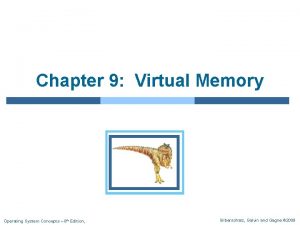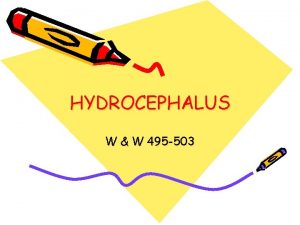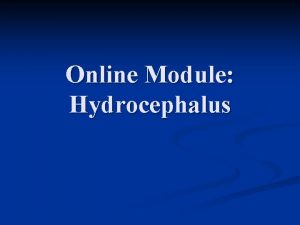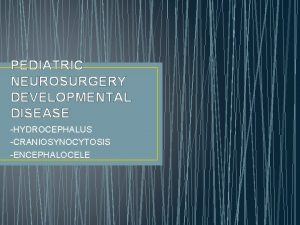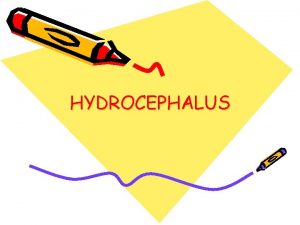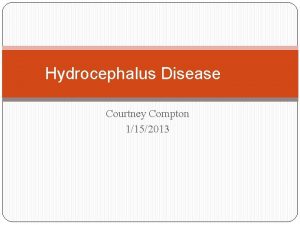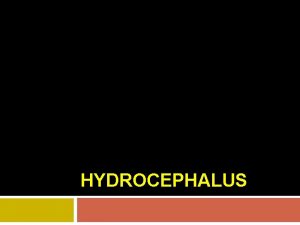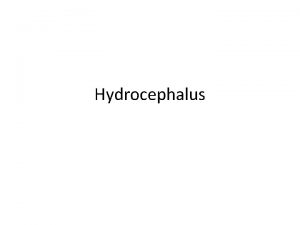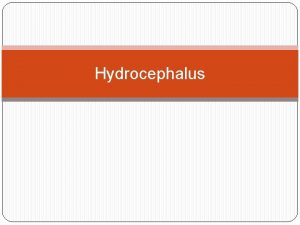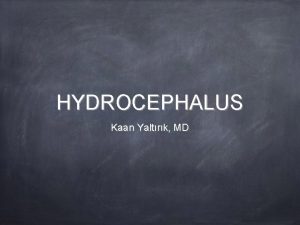HYDROCEPHALUS HYDROCEPHALUS What is hydrocephalus n Commonly known





























- Slides: 29

HYDROCEPHALUS

HYDROCEPHALUS

What is hydrocephalus? n Commonly known as water in the brain n It is an abnormal accumulation of cerebrospinal fluid (CSF) within the cavities called ventricles inside the brain.

n Cerebrospinal fluid (CSF)- is a liquid produced by the chorid plexius found with in the ventricles of the brain. It surrounds the brain and spinal cord, acting as a protective cushion against injury.



Symptoms n Baby’s head abnormally enlarges n soft spot(fontanel) may be tense & bulging n scalp may look thin & glistening n delayed mental development

Continued Symptoms n scalp veins may have n n n unusual fullness Feeling baby’s head along sutures bones are separated vomiting sleepiness irritability downward deviation of the eyes

Causes n Aqueductal obstruction n Neural Tube Defects or myelomeningocele n Intraventricular hemorrhage n Meningitis n Head trauma n Tumors n Arachnoid Cysts n Dandy Walkers Syndrome

Hydrocephalus may lead to n mental retardation or n n brain damage epileptic seizures neurological injury progressive dementia And death

Extreme cases

Diagnosing Hydrocephalus

Diagnosing n Ultrasound n Computed Tomography (CT Scans)

Diagnosing n Magnetic Resonance Imaging (MRI) n Amniocentesis

Diagnosing n Imaging studies/ X-Rays n Lumbar puncture (spinal tap) n And Prenatal risk screening (PRP)

Prevention n Prenatal Hydrocephalus is congenital therefore not preventable, but it can be treated. n If left untreated or in extreme cases may lead to death.

Treatment n Open fetal surgery n shunt placement n ventriculostomy n there are drugs like acetazolamide, glycerol, furosemide, digoxin& isosobride to postpone surgical placement of a shunt.





Shunt Placement n A shunt is a flexible tube about 1/8” in diameter, and is made of n n n n soft and pliable plastic usually silastic Shunts divert the flow of CSF from the ventricles into the body usually the abdominal cavity or atrium Shunts are placed into the child’s CSF system, and have a catheter (tubing) and a flow control mechanism (one way valve) Most shunts have an access area where testing can be done with a fine gauge needle One portion of the tube is inserted into the ventricles and is called the ventricular catheter Then the peritoneal/atrium catheter is inserted into the peritoneal cavity or the atrium A valve regulates the pressure of the CSF flow and prevents backward flow of into the ventricles There are 6 different types of shunts



After shunt care n Regular Follow up visits n n with the Drs shunt site should be cleaned eyes examined regularly CSF pressure should be checked to make sure shunt is working CSF should be checked periodically to be sure there Is no infection

Risks of a Shunt n Possible bleeding under the outermost covering of the brain known as subdural hematoma n infection (may cause loss of intelligence) n stroke n shunt failure/malfunction n abdominal injury n over drainage of the ventricles n death

Shunt malfunction or infection n Enlargement of head n irritability n fontanel is tense, and n Sleepiness upright n prominent scalp veins n swelling along shunt tract n vomiting n downward deviation of the eyes n less interest in feeding n fever n redness along the shunt tract

Outcomes of shunt n Complications occur in about 30 % of patients, but only 5% are serious or long term. n 25% to 80% of patients experience long term improvement

In conclusion, congenital and acquired Hydrocephalus is a condition not a disease, it may not be prevented, but it can be treated. If left untreated it may cause many disabilities, complications, and even death.
 Types of optical storage
Types of optical storage Agaricus commonly known as
Agaricus commonly known as A commonly cited hazard for stairways and/or ladders is
A commonly cited hazard for stairways and/or ladders is Water thief appliance
Water thief appliance Altered cognition in older adults is commonly attributed to
Altered cognition in older adults is commonly attributed to Commonly confused words jeopardy
Commonly confused words jeopardy Poriferans are
Poriferans are A commonly cited hazard for stairways and or ladders is
A commonly cited hazard for stairways and or ladders is Virtual memory is commonly implemented by
Virtual memory is commonly implemented by Technician a says that a hoist can be stopped
Technician a says that a hoist can be stopped Development of a truncated cylinder
Development of a truncated cylinder Website is a collection of *
Website is a collection of * List three of the commonly used assembly constraints
List three of the commonly used assembly constraints Most commonly used system
Most commonly used system Commonly misspelled homophones
Commonly misspelled homophones Commonly confused words paragraph
Commonly confused words paragraph Multinational financial management an overview
Multinational financial management an overview A pie diagram is also called
A pie diagram is also called Signing naturally 5:8
Signing naturally 5:8 Abused children commonly exhibit
Abused children commonly exhibit Classification of clutches
Classification of clutches History is the lie commonly agreed upon
History is the lie commonly agreed upon What symbol is commonly used for half-section view?
What symbol is commonly used for half-section view? Financial difficulties are commonly caused by overspending
Financial difficulties are commonly caused by overspending Alcohol is the most commonly used drug in our society
Alcohol is the most commonly used drug in our society Methods are commonly used to
Methods are commonly used to Half stem curl
Half stem curl Sodium hydroxide relaxers are commonly called:
Sodium hydroxide relaxers are commonly called: Narrative paragraph
Narrative paragraph A pneumatic drill is commonly used
A pneumatic drill is commonly used








